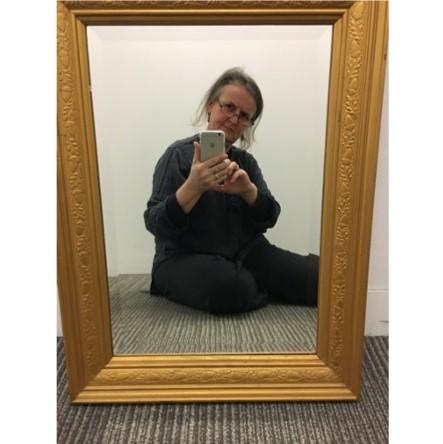It’s all in how you see it: Writing for Reflective Practice

It’s all in how you see it: Writing for Reflective Practice.
Dr Linda Westphalen - AEA Executive Committee member (School of Education)
Reflection, that difficult genre of writing, is increasingly common in our university assessments, especially in the emerging contexts of Work Integrated Learning (WIL) and Employability. It requires (ironically perhaps) perspective.
When you look in a mirror, you see an image of yourself, but it isn’t reality. Mirrors warp and limit reality, often accentuating imperfections. Our naughty subjective eyes add their own biases, sometimes by the kilogram. Unless we’re narcissists being fitted for a posh suit, we tend to see our reflective flaws all too readily and our assets sporadically, if at all.
The frame of a mirror limits our view. We’re reversed images, bits of face and body, from which we construct a composite ‘whole’ replete with distortion, distraction and spaces. We don’t see a total picture even in a mirror where we can see ourselves from top to toe, because we can’t ever see our whole self, not even if we use a lot of mirrors. We need others to see with us to do that.
I really enjoy working with staff on things they need to be better teachers. In my teaching classes, my students and I consider Reflective Practice, and we do indeed, use the simple mirror to understand the misrepresentation it imposes and our already flawed perception. As the teaching unfolds, we come to a central question: If, in reflection, what we see is a distortion, how do we get a more accurate picture, with more balanced perspectives?
According to Stephen Brookfield (1995), we shouldn’t use mirrors at all. We need four lenses, not one or two. We need autobiographical experience, tempered by the eyes of our colleagues and of our students and relevant theoretical and/policy perspectives on our content and our pedagogy. It’s via these lenses that we can more factually and pragmatically assess what happened, our role in what happened, its consequence and impact.
Put simply, reflection on action comes down to four easy questions.
- What happened?
- What are the facts?
- Why does it matter?
- Based on my experience of this event that happened, how will I now change my practice?
All of these elements contribute to a coalescent praxis: it is the self in a social environment buoyed by the schema relevant to the discipline area and tempered by foresight, co-sight and hindsight.
So how does this work, really?
Let me illustrate by example. A person, Kim, is placed in a context: let’s say a school. They attend a Maths class and see twelve year old Child A poking thirteen year old Child B with a ruler. Kim asks them to stop. Instead of stopping, A pokes B again, harder, such that B complains. Kim steps in and, amid loud protest, removes the ruler. A complains that they have been robbed and now can no longer do their Maths. Kim says ‘tough’ and declines to give back the ruler. A steals B’s ruler. More complaints. The supervising teacher intercedes.
Kim feels failure. They reflect: I’m an idiot. I should have given back the ruler.
That is simple mirror reflection, Kim. We need a bit more balance.
What happened? (No. What actually happened? NO emotion: what are the facts?) Did you try to prevent an act of (mild) violence and act in the best interests of both A and B? Yes, you did, but success was a bit limited.
What else could you have done? Could you have removed child A from the situation? Or child B out of danger? Could you have left it to the teacher to resolve?
What is the peer teacher’s view of your solution?
Now a more theoretical-policy perspective: adolescent development means that behaviour is driven, partly, by hormones which upset attention span, mood and generally make middle years teaching the exhilarating journey that it is. These humans will return as balanced (we hope) young men and women in their 20s. The student perspectives we have from them are probably not that helpful. The perspective we have from the other students in the class are predictable: ‘They’re annoying, disrupting my learning and someone needs to do something.’ You did something, Kim. And while it may not have worked exactly as you wanted, you did DO something.
What is the school’s policy on behaviour management? Do the children involved have a history of antagonism or a learning disorder that you don’t know about? Was student A’s point to disrupt the class? Would they have found a way to do that with or without your intervention?
According to the Australian Professional Standards for Teachers (APST) which are criteria by which registered teachers maintain accreditation, you must provide a safe and supportive learning environment. You must handle challenging behaviour. Do you have experience in doing that? Did you do your best to deal with this challenging situation?
Bottom line: Did you, to the best of your ability and experience, try to enact the APST about student safety and behaviour? Yes? Well, then while it might not have been a perfect solution (and there aren’t a lot of these around), it was a solution worth trying. Neither child was at risk of real injury, but it might have progressed to that had you not stepped in. Regardless of the outcome you will learn from this experience and you will try new approaches, different approaches, combinations of approaches, next time.
And that’s reflective practice.
Let’s not treat reflection as if it’s a simple mirror on events. The better course of action is to reflect on the contextualised event, based in fact and considerate of experience, student perspectives, peer perspectives and theoretical literature. It’s more accurate and useful than self-admonishment, and it’s kinder too.
(Brookfield, S. (1995) Becoming a critically reflective teacher. Jossey-Bass: San Francisco.)
